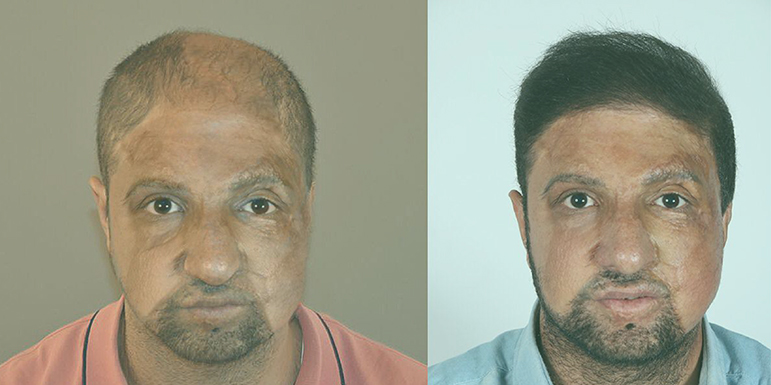
Burned or Injured Regional Hair Transplant
Treating patients with burns or scarred scalp hair loss can be difficult for both the hair transplant specialist and the patient. The reason for the lack of hair growth on the scalp is not only in cases of burns, but can also be caused by a traumatic result due to a blow or accident. Hair transplantation on burned or traumatized scalp should be performed after the completion of other necessary reconstructive procedures. This is a multi-stage process that usually involves several years of surgery. This is because graft harvesting is not as reliable as with healthy, uninjured skin and may need to be repeated to achieve sufficient density. Also, different areas that have suffered damage may need to be addressed in separate procedures.
In burned or scarred area hair transplantation, there are several limiting factors that determine the patient's suitability for hair transplantation, the amount of hair loss and the availability of suitable donor hair. Follicular unit extraction, FUE or strip follicular unit transplantation FUT can be used.
Burn injuries from scalds, including chemical burns, flames, steam, hot water and cooking oils, and rarely electrical injuries, are part of injuries affecting the head and neck area and the general body. In such cases, we often observe microstomies, upper and lower eyelid and lip problems, and functional problems resulting in narrowed nostrils. Once the acute treatment of life-threatening problems has been completed and wound healing is complete and functional deficiencies have been addressed, the hair transplantation process can begin. Complete destruction of the hair follicle is often associated with deep burns, which also cause severe scarring, making hair transplantation more difficult. Such patients experience a loss of self-confidence and the scars have a huge impact on their quality of life, moreover, they can be a constant reminder of the traumatic event.
Many patients may opt for non-surgical options to address their visible differences, but later on, with technology now offering truly different options, we are able to offer a variety of options for hair transplantation on burned skin with very good results.
Create a preliminary interview request for all your questions about Hair Loss and PRP procedures.
Scientific
Safe
Effective
Burn Alopecia Treatment Hair, Beard and Eyebrow Transplantation
Since the hair transplant procedure can be performed with hair from a healthy donor area, it is often possible to perform hair transplantation in multiple sessions to simulate the appearance of normal density in the treatment of burn alopecia and because it is already damaged tissue. If the number of grafts that can be harvested from the donor area is not sufficient, hair transplantation can also be performed from the patient's body hair.
Please note that for most burn cases, the people who will provide hair transplantation services do not have sufficient skills, training, infrastructure, resources or possibly case experience. In fact, there is very little published literature on burn scar alopecia hair transplantation. For this reason, while doing your research, I recommend that you prefer hair transplant clinics that have worked with such cases before and have certain experience. Unfortunately, most of my patients who came to me for burn scar hair transplantation have been deprived of these developments by stopping research for years because they were told that hair transplantation could not be done before.
In the same way as in hair, such burn problems can also occur in beards, mustaches and eyebrows. In men, if the roots of the beard or moustache hair are damaged, scarring alopecia is likely to occur. In hairy men, especially those with dark hair, this beard or moustache hair loss is more noticeable than in those with normal skin color and texture. A stubble beard can cover the problem if the scar is small, but if it is larger, this is not possible. For this reason, hair transplantation remains the best option for those with this kind of scarring on their beard and moustache. Although the scalp can be used as a donor, the best match will be FUE-derived beard hair.
Hair transplantation is currently the only permanent treatment for hair loss and is a solution limited by the availability of donor hair. Burn scar hair transplantation can contribute to appearance problems in these patients, giving a great deal of satisfaction in terms of self-confidence and aesthetics. Hair transplantation to these patients can be completely natural looking, restore hairlines, cover small to medium sized areas of scalp burn scar alopecia, and allow for the regrowth of destroyed beards and mustaches. There are currently no globally accepted outcome measures for hair transplantation in burn scar alopecia. I believe that with the development of patient satisfaction criteria, it will become much more recognized in the future and will give hope to patients with such problems, because hair transplantation offers a very smart solution.
